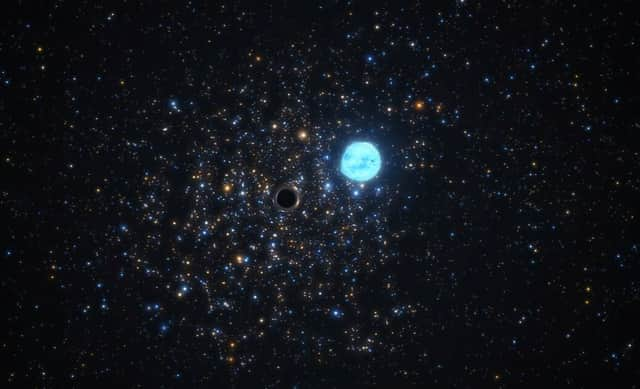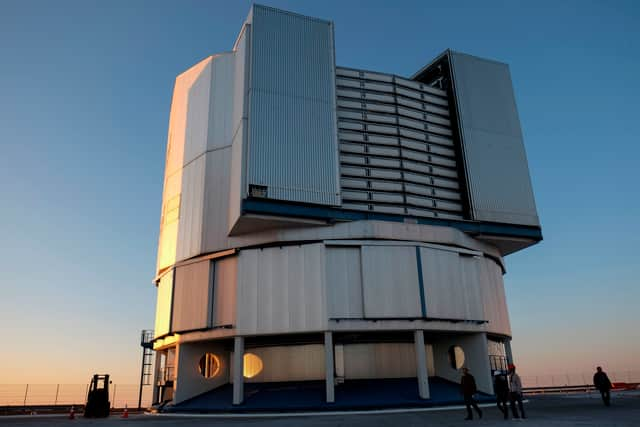Liverpool led team of scientists discover black hole just outside our galaxy - 160,000 light-years from Earth


A team of astronomers led by Liverpool John Moores University (LJMU) have discovered a black hole just outside our galaxy.
It is believed to be the youngest discovered to date and is 160,000 light-years from Earth in a cluster of stars beyond the Milky Way.
Advertisement
Hide AdAdvertisement
Hide AdScientists located the small black hole by studying the way it influenced a nearby star and the method could be key to finding more of the unseen behemoths.
Sara Saracino, from the Astrophysics Research Institute of LJMU likened the technique to “Sherlock Holmes tracking down a criminal gang from their missteps.”
She explained: “We are looking at every single star in this cluster with a magnifying glass in one hand trying to find some evidence for the presence of black holes but without seeing them directly.
“The result shown here represents just one of the wanted criminals, but when you have found one, you are well on your way to discovering many others, in different clusters.”
Details of the black hole
Advertisement
Hide AdAdvertisement
Hide AdAccording to the study published in the Monthly Notices of the Royal Astronomical Society this black hole is around 11 times as massive as our sun.
Although that sounds big, scientist say it is fairly tiny, relatively speaking. Some are billions of times bigger.
This one lurks among a group of stars named NGC 1850 in the Large Magellanic Cloud (LMC), a neighbouring ‘dwarf’ galaxy to ours.


It is the first time a black hole has been detected among a young group of stars. They are only around 100 million years old - a blink of an eye on cosmic scales.
Advertisement
Hide AdAdvertisement
Hide AdThere are an estimated 100 million black holes in our galaxy the Milky Way alone. Just a couple of dozen have been spotted so far.
It is believed almost every large galaxy - including the Milky Way - has a supermassive black hole at its heart.
How the black hole was detected
The international team used data collected by the European Southern Observatory’s Very Large Telescope (VLT) in Chile over two years.
Lead author Dr Saracino says the ‘smoking gun’ that put her on the trail of the black hole was the exertion of its huge gravitational force on a nearby star that is five times as big as the sun.
Advertisement
Hide AdAdvertisement
Hide AdThe presence of the black hole distorts the star’s shape and also affects its orbit.


Normally, black holes are identified from the way they interact violently with an accreting disc of gas and dust. As they shred this material, copious X-rays are emitted. It is this high-energy signal telescopes detect - not the black hole itself.
In this unique case, it was one of the stars in a young cluster known collectively as NGC 1850, that gave the game away.
They are the brightest in the LMC, which lies in the southern constellation of Dorado, called the Goldfish or the Swordfish.
Black hole hunting
Advertisement
Hide AdAdvertisement
Hide AdA scanner called MUSE (Multi Unit Spectroscopic Explorer) has been mounted on the Very Large Telescope, which is located in Chile’s Atacama Desert.
Co author Dr Sebastian Kamann, also from Liverpool, said: “MUSE allowed us to observe very crowded areas, like the innermost regions of stellar clusters, analysing the light of every single star in the vicinity.
“The net result is information about thousands of stars in one shot, at least 10 times more than with any other instrument.”
This enabled the researchers to single out the odd star’s strange movement - signalling the presence of the black hole.
Advertisement
Hide AdAdvertisement
Hide AdThe Extremely Large Telescope (ELT) in Chile, set to start operating later this decade, will allow astronomers to find even more hidden black holes.
“The ELT will definitely revolutionise this field,” Dr Saracino said. “It will allow us to observe stars considerably fainter in the same field of view, as well as to look for black holes in globular clusters located at much greater distances.”
It is believed almost every large galaxy - including the Milky Way - has a supermassive black hole at its heart. Nobody knows how they got there. New telescopes and techniques are giving us better ways of looking at these giants.
They have a spherical boundary known as an “event horizon”. Within this sphere light, energy and matter are inescapably trapped.
Comment Guidelines
National World encourages reader discussion on our stories. User feedback, insights and back-and-forth exchanges add a rich layer of context to reporting. Please review our Community Guidelines before commenting.
